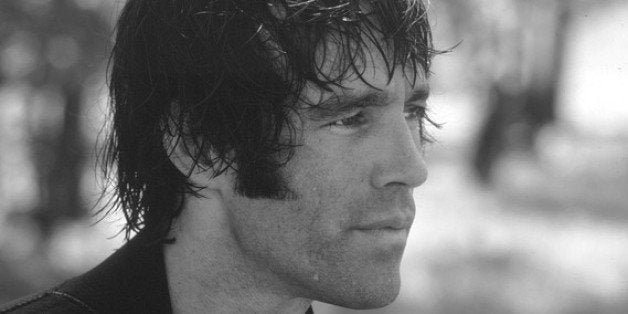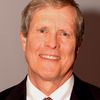
When Mark Crooks, PhD, endured disfiguring cancer at age 8, he toughened up and battled a pernicious disease for the rest of his life. In spite of four recurrences, he thrived for the next 57 years.
Ahead of me loped a towering athlete with one remaining lung. Cancer had destroyed his other lung two years earlier, although he never smoked cigarettes and had been a running pioneer since the 1970s. He was my benchmark for physical fitness -- my inspirational deliverer from seven years of juvenile nicotine addiction -- so I always took advantage of our infrequent opportunities to go jogging together.
Dappled sunlight spilled upon the forested trail where we ran, and I felt elation to see Dr. Mark Crooks pulling ahead, effortlessly. Though disabled with a single lung, he still could trounce me on the trail. As his wide shoulders and dark mane of wavy hair shape-shifted into elm tree shadows ahead, I reflected upon self-empowered living that he embodied.
He was a proud man who knew much about cancer, pain and rehabilitation. When we jogged that spring day near his home in south Kansas City, he had already survived cancer for 55 years, battling nerve, thyroid and lung cancers. He would face two more metastatic bouts -- prostate and liver -- before it would be over.
Cancer imposed egregious injustices upon an athlete and former marine who had earned a doctoral degree in exercise physiology and had dedicated many years to inspiring and teaching stricken men how to recover from heart attacks. His first mitochondrial mutation followed a head-and-neck X-ray in infancy. Then a sarcoma appeared on his neck at age 8.
But I knew his mind well after three decades of friendship. He wasn't thinking about the injustice of metastatic disease. He was thinking about a beautiful day -- fresh air, sweet scents of budding trees and his daily mastery over inertia. He wasn't trying to intimidate me with superior conditioning, either. Mark just ran far and away in the manner he chose to spend part of each day. His only unrivaled competitor was the nemesis lurking within since childhood. Early immersion in mortality propelled his life course and had given him uncommon determination to fight evil with science, experimentation and risk-taking.
Most lives cannot be summed up by a single incident; rather, most human stories are collections of actions and reactions, an amalgam becoming a narrative, of plots and subplots spanning decades. This was also true for Mark's story, but in one oddly defining moment he leapt from the apex of a bridge crossing a dangerous river, plunging 10 stories and landing in nine feet of coffee-colored water.
For weeks he had honed his physique with free weights and running, living a Spartan existence and practicing mid-air orientation through trial jumps in the Missouri Ozarks. From successively higher limestone cliffs, he had jumped into space, landing as if a professional cliff jumper. He then picked the Paseo Bridge in Kansas City, a final jump location from which several tortured men had committed suicide.
As he launched into the void from the lip of that bridge, an 18-wheeler blasted by him. Wind draft pushed his torso forward, introducing the possibility that he would land imperfectly and break his back. Then, in midair, he mounted an invisible bicycle and pedaled for the finish. His body became vertical within a free-fall reaching 63 miles per hour, and he slipped splash-less into choppy, mucky currents. Seconds later, he exploded through the surface, arms extended in Olympic victory.
Jumping from a bridge into a river did not define Mark, but that single courageous act illuminated his incandescent spirit while elaborating his message: Humans can achieve greater wellness by taking calculated risks.
His risks were bold and brash; the doctor became his own experiments. Yet he did not advocate for mere mortals to follow in his jump stream. He saw risk as relative: one man's Arctic Circle trek is another man's casual day hike; one woman's skydiving free-fall is another woman's tethered zip-line. Risk lies more in the heart of the actor than in the act itself.
Endorphins are a gift for taking risks: opiate pretenders that can reduce pain and create well-being. Those same neurotransmitters had also molded an image of contentment that I witnessed in a super-athletic, one-lung man leaving me to follow his footprints in damp loam of a Kansas running trail.
I could also see Mark in the flow, and to him that word meant more than going with the flow. Flow means unwavering immersion in activity -- the ultimate way to harness emotions in service of high-performance, a loss of reflective self-consciousness. The pinnacle of the flow experience includes feelings of spontaneous joy and rapture. Often achieved through planned risks, flow is one critical wellness strategy to combat stress hormones. Taoism has for millennia recognized this mindset as "action of inaction" or "doing without doing." An assertive man with many reasons to doubt his prowess had conquered uncertainty, depression and anxiety as he achieved flow transcendence -- capturing states of being that had also empowered Michelangelo as the Master painted the Vatican's Sistine Chapel.
Whether swimming 375 miles nonstop in the frigid Missouri River from Kansas City to St. Louis for five grueling days or scaling the exterior of the tallest skyscraper in the Midwest, Mark commanded intense focus with each selected feat. He pushed himself forward with wisdom succinctly articulated by Friedrich Nietzsche, the 19th century existentialist: "That which does not kill us makes us stronger." That which did not kill Mark made him stronger, and he gained strength with leaps, dives and near-misses.
Following our final run together, Mark shared his thoughts about aging, disease and decline, an unholy triumvirate that had visited him when much too young. "I still have a warrior mentality," he said. "I'm a fighter. My whole life has been about overcoming things. Adopting fitness as a way of life and part of your daily regimen will keep you more mentally stable.
"I still feel that the best of my life is yet to come. I have certain optimism because I don't realize the limitations that most 63-year-old men have."
His hourglass emptied two years later within the solitude of the Kansas City Hospice. Even then, he shoved an intravenous cart around the corridors for glorious minutes of independent movement. Though death was at his doorstep, he still defied mortal inevitability, a diminished man but a noble spirit unwilling to submit until left no further options.
Mark Crooks, PhD, died on July 8, 2010. He finished life on his terms. He prevailed for decades over disease, depression, and disinterest. He found satisfying self-expression through running shoes and countless T-shirts drenched with sweat. And he defied aging, not to deny the inevitable but to thwart its pace, a warrior to the end.
